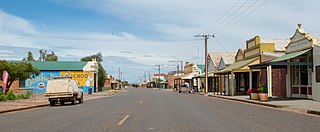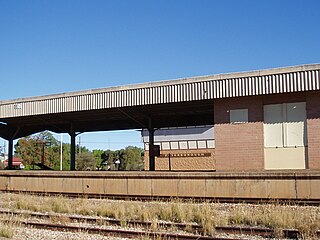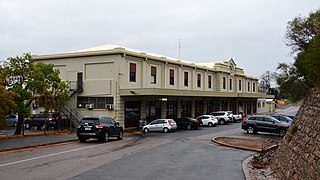Related Research Articles

Pichi Richi Railway is a 39 kilometres narrow-gauge heritage railway in the southern Flinders Ranges of South Australia between Quorn and Port Augusta. For much of its length the line lies in the picturesque Pichi Richi Pass, where the line was completed in 1879 as work proceeded north to build a railway to the "Red Centre" of Australia – the Central Australia Railway.

Peterborough is a town in the mid north of South Australia, in wheat country, just off the Barrier Highway. It was originally named Petersburg after the landowner, Peter Doecke, who sold land to create the town. It was one of 69 places in South Australia renamed in 1917 due to anti-German sentiments during World War I.
Australians generally assumed in the 1850s that railways would be built by the private sector. Private companies built railways in the then colonies of Victoria, opened in 1854, and New South Wales, where the company was taken over by the government before completion in 1855, due to bankruptcy. South Australia's railways were government owned from the beginning, including a horse-drawn line opened in 1854 and a steam-powered line opened in 1856. In Victoria, the private railways were soon found not to be financially viable, and existing rail networks and their expansion were taken over by the colony. Government ownership also enabled railways to be built to promote development, even if not apparently viable in strictly financial terms. The railway systems spread from the colonial capitals, except for a few lines that hauled commodities to a rural port.

Terowie is a small town in the Mid North region of South Australia located 220 kilometres (137 mi) north of the state capital of Adelaide. It is located in the Regional Council of Goyder. Terowie retains a number of authentic and well preserved 1880s buildings, and has been declared a "historic town". It also remains a town of interest to those interested in rail history. Although now a very small town with few facilities, Terowie remains a popular destination for photographers, historians, and rail buffs.

Rail transport in the Australian state of South Australia is provided by a number of railway operators who operate over the government-owned railway lines. The network consists of 1435 mm standard gauge links to other states, the 1600 mm broad gauge suburban railways in Adelaide, a freight-only branch from Dry Creek to Port Adelaide and Pelican Point, a narrow-gauge gypsum haulage line on the Eyre Peninsula, and both copper–gold concentrate and coal on the standard-gauge line in the Adelaide–Darwin rail corridor north of Tarcoola.

The Trans-Australian Railway, opened in 1917, runs from Port Augusta in South Australia to Kalgoorlie in Western Australia, crossing the Nullarbor Plain in the process. As the only rail freight corridor between Western Australia and the eastern states, the line is economically and strategically important. The railway includes the world's longest section of completely straight track.

The South Australian Railways T class was a class of 4-8-0 steam locomotives operated by the South Australian Railways. Several were sold to the Tasmanian Government Railways; some others operated on the Commonwealth Railways.

Peterborough railway station is located on the Crystal Brook-Broken Hill line in Peterborough, South Australia.

Port Augusta railway station is a railway station located on the Adelaide-Port Augusta railway line in Port Augusta, South Australia.

Terowie railway station was located on the Roseworthy–Peterborough line in the South Australian town of Terowie.
Ucolta is a locality in the Mid North region of South Australia. It is named for a railway station on the Broken Hill-Port Pirie railway line. Trains no longer stop at Ucolta. It is also where the Barrier Highway first meets the railway line, and the Wilmington–Ucolta Road which connects across the northern side of the Mid North, providing the shortest road route from Western Australia and Eyre Peninsula via Port Augusta to Broken Hill and New South Wales.

The Roseworthy–Peterborough railway line was a railway line on the South Australian Railways network. It extended from a junction at Roseworthy on the Morgan railway line through Hamley Bridge, Riverton, initially to Tarlee, then extended in stages to Peterborough.

Burra railway station was located on the Roseworthy-Peterborough railway line. It served the township of Burra, South Australia.
Mount Bryan railway station was located on the Roseworthy-Peterborough railway line. It served the town of Mount Bryan.

Merildin railway station was located on the Roseworthy-Peterborough railway line in the South Australian town of Mintaro.
Tarlee railway station was located on the Roseworthy-Peterborough railway line. It served the town of Tarlee, South Australia.
Hallett railway station was located on the Roseworthy-Peterborough railway line. It served the town of Hallett, South Australia.
Saddleworth railway station was located on the Roseworthy-Peterborough railway line. It served the town of Saddleworth, South Australia.

Manoora railway station was located on the Roseworthy-Peterborough railway line. It served the settlement of Manoora, South Australia.
References
- ↑ "Opening of the Hallett and Terowie Railway". Evening Journal . Adelaide, SA: National Library of Australia. 15 December 1880. p. 3 Edition: 2nd. Retrieved 30 November 2015.
- ↑ Quinlan, Howard; Newland, John (2000). Australian Railway Routes 1854 – 2000. Redfern: Australian Railway Historical Society. pp. 55, 56, 58. ISBN 0-909650-49-7.
- ↑ Gumbowie
- ↑ 402, goods train, Gumbowie, SA, [1966]
- ↑ "Steam Extravaganza" (PDF). SteamRanger Enthusiast Pages. Retrieved 30 April 2024.